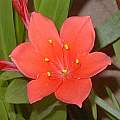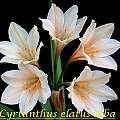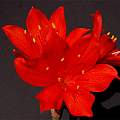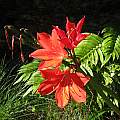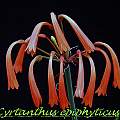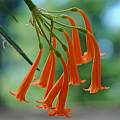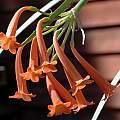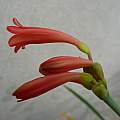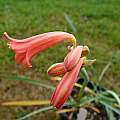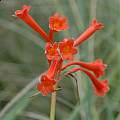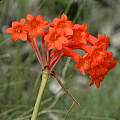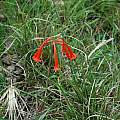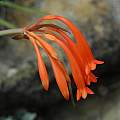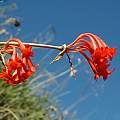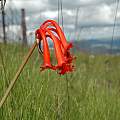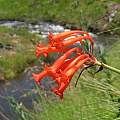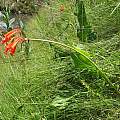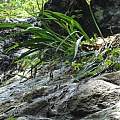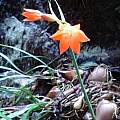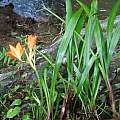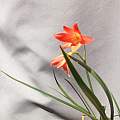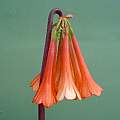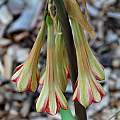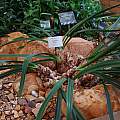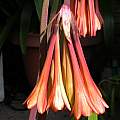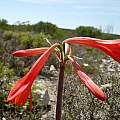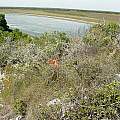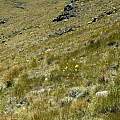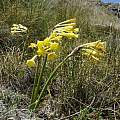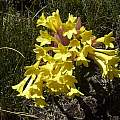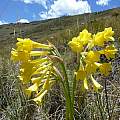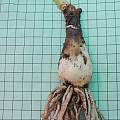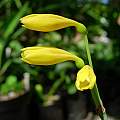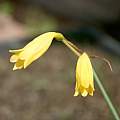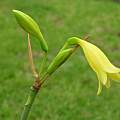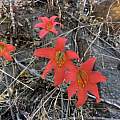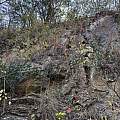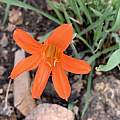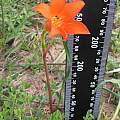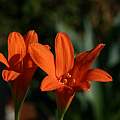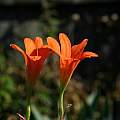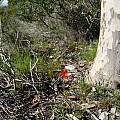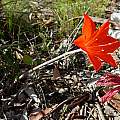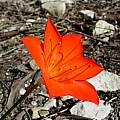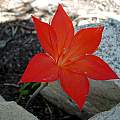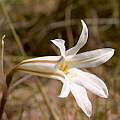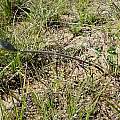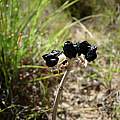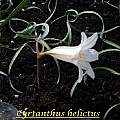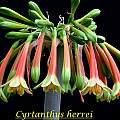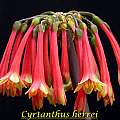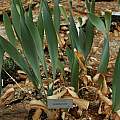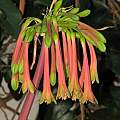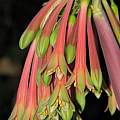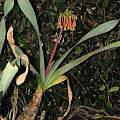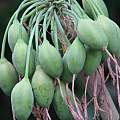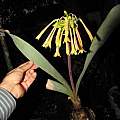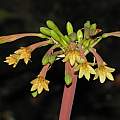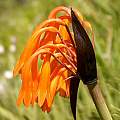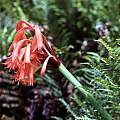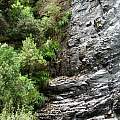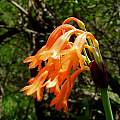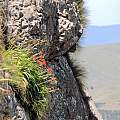Cyrtanthus is a large genus of the Amaryllidaceae family native to South Africa. Species grow in a wide range of habitats including damp bushy stream-edges, as epiphytes on other plants, and in near desert conditions. A good reference is Graham Duncan's The Amaryllidaceae of Southern Africa written in 2016. Cyrtanthus species e-j are found on this wiki page.
Cyrtanthus Hybrids - Cyrtanthus a-c - Cyrtanthus k-o - Cyrtanthus p-z - Cyrtanthus index
Cyrtanthus elatus (Jacq.) Traub was previously known as Vallota speciosa aka George Lily, Scarborough lily. This is one of the most striking members of the genus and is now grown worldwide for its cut flowers. Complaints are often heard that this species flowers very erratically in cultivation, but some forms are just naturally more floriferous than others. The form usually cultivated by growers reproduces vegetatively at a sometimes alarmingly rapid rate. The clumps become overcrowded very quickly and if they are not lifted, split up and replanted on a very regular basis, flowering can cease. They prefer full sun rather than shade and flower mainly in summer. Plants grow to 60 cm high. The first photo is by Doug Westfall. The most cultivated colour is scarlet, but now pink and white forms are available. The second photo by Bill Dijk is of a white one. The third photo shows a variety that Bill is calling var. delicata. This does not seem to be a published name or accepted variety, so is perhaps a garden cultivar being grown worldwide. The fourth photo was taken by Hans Joschko. The last two photos were taken by Cameron McMaster, Outeniqua Pass, southern Cape.
Cyrtanthus epiphyticus J.M.Wood is a very attractive species from the Eastern Cape and KwaZulu-Natal, with pendulous reddish-orange flowers in spring, September-October in the wild. Photo by Bill Dijk. The flower tube is narrow and curved and the lobes roundish with blunt recurved tips. This species is epiphytic and found on trees, boulders and in rock crevices in moist conditions. Photos by Bill Dijk, Mary Sue Ittner, Bob Rutemoeller, and Alessandro Marinello.
Photos by Mary Sue Ittner and Bob Rutemoeller taken January 2010 at Maclear and Naude's Nek.
Photos below were taken by Cameron McMaster at Maclear.
Cyrtanthus eucallus R.A.Dyer is native to only a small area in eastern Mpumalanga. It is listed as threatened on the SANBI Red List of South African Plants. The plants grow in scattered clumps on large boulders of cliff faces in somewhat shaded conditions with dappled light. This is an evergreen species that flowers in midsummer. The first four photos from iNaturalist were taken in Mpumalanga by juddkirkel in February and shared under a CC BY-NC license. The last photo was taken by Uluwehi Knecht.
Cyrtanthus falcatus R.A.Dyer is a beautiful trouble-free plant from KwaZulu-Natal. The "shepherd's crook" inflorescence emerges without warning in late spring and early summer. It is red or pinkish flushed green and is soon followed by broad bright green foliage. This is a remarkably tough species that easily withstands moisture during its winter dormant period. Height: to about 30 cm. Photo #1 by Rob Hamilton. Photo #2-3 from Mary Sue Ittner of the first bloom of plants grown from seed and the leaves of plants shown in the bulb house at Kirstenbosch National Botanical Garden. Photo #4 from Alan Horstmann. Photo #5 from Byron Amerson shows 2-month-old seedlings.
Cyrtanthus fergusoniae L.Bolus is a deciduous or evergreen species with bright red tubular flowers. This is not an easy plant to maintain over an extended period, needing much less water in summer. It is found in the wild in the Agulhas Plain. It grows on loam or sandy soil, usually on limestone, and flowers in summer. Height: to 35 cm. Photos by Cameron McMaster.
Cyrtanthus flanaganii Baker is known as the Yellow Dobo Lily. It grows in damp turf, on wet cliffs from 2000 to 3300 meters elevation. It is endemic to the Eastern Mountain Range (Drakensberg Alpine Centre) of South Africa where it withstands snow and frost. It flowers from November to December. Flowers are sweetly scented and bright yellow with a long narrow tube. Leaves are produced with the flowers and are blunt tipped. The first four photos were taken by Cameron McMaster. Height: about 20 cm. The last photo from Mary Sue Ittner shows a bulb on a 1 cm grid.
Cyrtanthus flavus Barnes is restricted to the southern coastal part of the Eastern Cape where it occurs in grassland that is waterlogged in summer. The leaves emerge in early spring prior to or at the same time as the flowers. Plants are dormant or semidormant during the dry winter months. This species is considered vulnerable. Photos by Cameron McMaster.
Cyrtanthus galpinii Baker is distributed from northern KwaZulu-Natal and eastern Mpumalanga to northern Limpopo, eastern Swaziland, and Zimbabwe. It is a dwarf species growing up to 20 cm with pink, orange or orange-red trumpet shaped flowers. The inner surface has six deep pink or orange-red longitudinal lines extending below the tepals and the outer surface is sometimes green striped. It is very similar to Cyrtanthus sanguineus but has narrower leaves and a more northern distribution. It is dormant in winter and flowers in August-September in its native habitat. The first three photos from iNaturalist were taken by Troos van der Merwe in Mpumalanga in July and the fourth by magdastlucia late July in KwaZulu-Natal and shared under a CC BY-NC license. The last two photos were taken by Nhu Nguyen.
Cyrtanthus guthrieae L.Bolus is an extremely rare species with bright red flowers that reflect a golden sheen in the sun. It is not too difficult to grow and with constant attention to avoid over-watering, it flowers faithfully every March-April in the Southern Hemisphere. It is dormant in summer, but may occasionally be evergreen. Height: about 15 cm high. This species is native to the lower sandstone slopes in the southwest Cape, flowering after fires. It is one of the rarest in South Africa, occurring in very localised spots in fynbos on the lower southern slopes of Soetmuisberg near Bredasdorp. It is known locally as the Bredasdorp lily and it occurs nowhere else in South Africa. Photos by Cameron McMaster who counted only 15 blooms when he visited the site to obtain these pictures of it in habitat and increasingly closer. The last is another close-up showing it flowering next to some large rocks.
Cyrtanthus helictus Lehm. occurs in sandy soil in sparse, dry grassland in the Eastern Cape. It has tiny tightly corkscrew leaves and trumpet-shaped white flowers with pink candy stripes and flowers in October in the wild. The first four photos were taken by Cameron McMaster, including photos of the fruit and seed. The final picture was taken by Bill Dijk.
Cyrtanthus herrei (F.M.Leight.) R.A.Dyer is an evergreen plant that occurs in the arid Richtersveld in the far northwestern corner of the Northern Cape. It is important to note that in nature this species grows on steep rocky walls in substantially shaded canyons. The general climate is hot and dry but their specialized niche tells us that they require some shade in cultivation, especially during hot weather. The species remains evergreen but grows mainly in the cool months. It should be kept dry during summer. The huge bulb should be planted with the neck and about two-thirds of the bulb above ground level. Height: to about 60 cm. Photos 1-2 were taken by Bill Dijk. Photo 3 was taken by Mary Sue Ittner in the bulb house at Kirstenbosch National Botanical Garden and shows the leaves.
The photos below were taken by Dylan Hannon of plants grown in Southern California. Photos 1-4 were from near Lekkersing. Photos 5-6 were from near Numeis (P. Bruyns 7216).
Cyrtanthus huttonii Baker is an Eastern Cape endemic with large, almost iridescent dark orange blooms and purple bracts. It is found in moist crevices along mountain streams and waterfalls or cliffs where there is underlying water for its roots. It flowers in mid-summer, but it is difficult to grow as its habitat is almost impossible to reproduce. Height range: to about 60 cm. Photos 1-4 by Cameron McMaster of the flowers and the habitat. The last photo was taken by Bob Rutemoeller on Gaika's Kop January 2010.
Some of the information about these species and how to grow them was furnished by Bill Dijk and Cameron McMaster.
Cyrtanthus Hybrids - Cyrtanthus a-c - Cyrtanthus k-o - Cyrtanthus p-z - Cyrtanthus index
